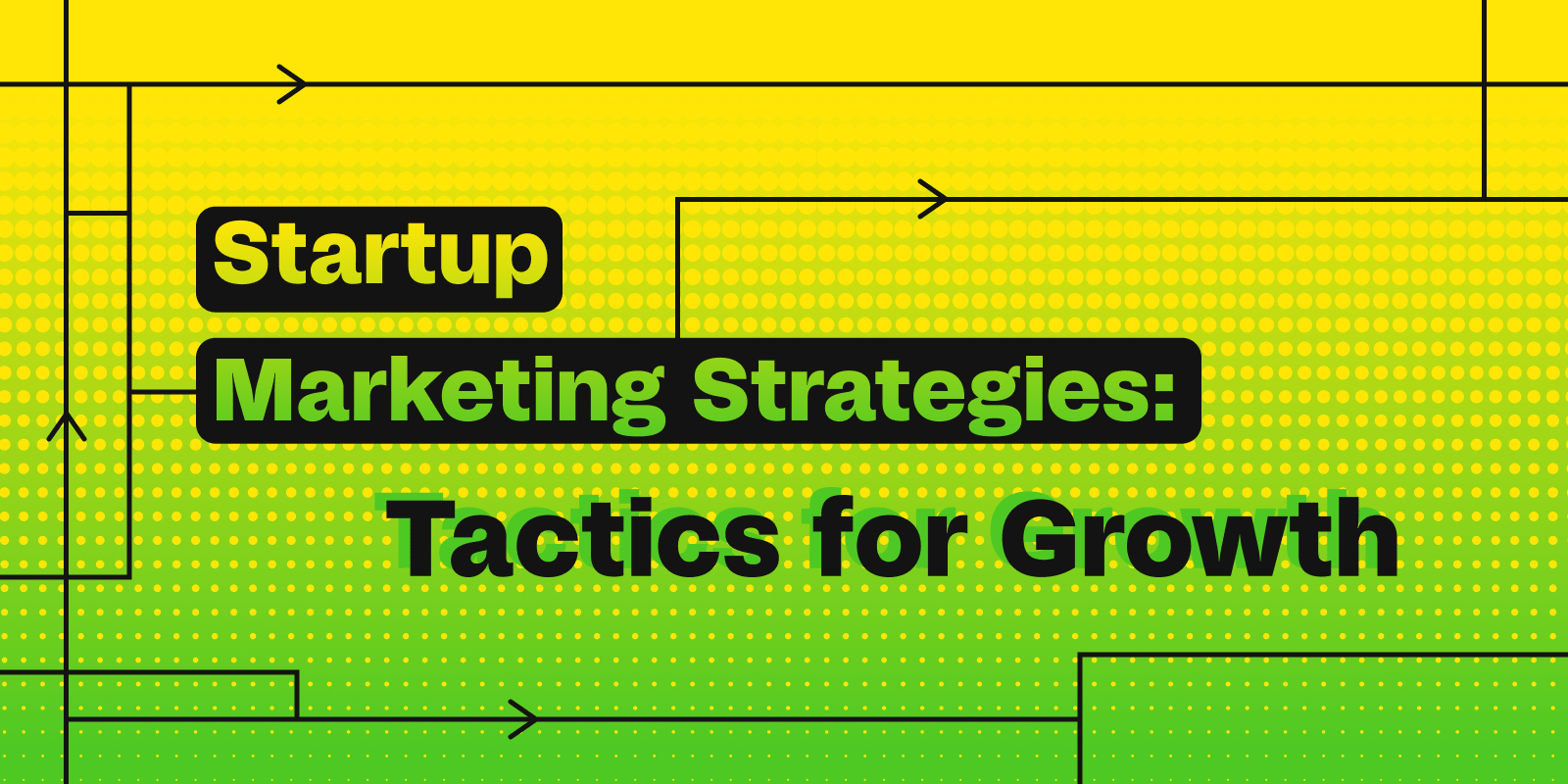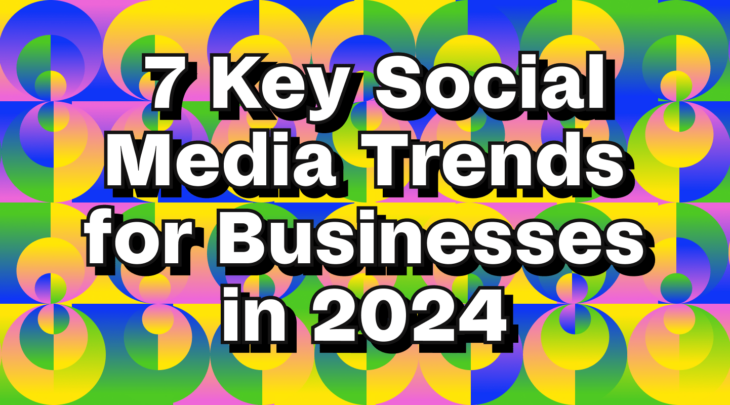“Optimize”, “scale”, “revamp”, “increase” — we hear marketers throw these words around all the time when it comes to driving results and pursuing growth, yet we rarely hear about the foundational steps that come before these tactical initiatives. Startups build everything from the ground up, and their marketing strategy is no exception. To drive immediate results with limited resources and historical data, startup marketing strategies must be innovative, testing- and result-driven, and ever-evolving to keep up with an always shifting market.
Despite the limitations on resources and time that ultimately come with a startup environment, marketing should never be swept under the rug when it comes to budgeting and planning for growth. Marketing is an absolute must for companies looking to drive brand awareness, a follower base, and consumer trust. Small businesses often pursue big goals — and rightfully so. Startups have the newness and innovation to leverage new trends and bring a fresh perspective to crowded markets filled with older legacy brands. To build from the ground up is often an opportunity and not a disadvantage, so long as startup marketers are able to proactively use it to pursue the most future-forward and culturally-relevant marketing strategies for their brand.
What is startup marketing?
Startup marketing is an effective marketing plan that focuses on driving rapid and measurable growth while adhering to limitations on time, resources and budget. Startup marketers are laser focused on achieving results that will build a solid foundation for future scaling, and tend to be extremely precise, strategic, and results-driven. Due to budget constraints, startup marketing often involves a combination of paid and organic strategies, both of which are monitored regularly to unlock platform-specific and data-backed insights.
One key philosophy of startup marketing is to do unscalable things in order to scale in the future. Paul Graham, a venture capitalist and co-founder of startup accelerator Y Combinator, commonly advises startup founders to “do things that don’t scale”. This advice might sound counterintuitive at first, but what Graham essentially means is that there is value in going to extraordinary lengths to delight your first users. Do things manually, recruit users one by one, then gradually automate the bottlenecks after you have gathered sufficient learnings from your initially deliberately narrow market. Don’t underestimate the power of compounding growth, and focus on understanding your core consumer base before scaling to larger or different markets.
What are 4 key types of startups?
There are a hundred and one ways to categorize different types of startups — the nature of a startup is to be idiosyncratic and unique. That being said, startups are typically categorized into 4 key types:
- Small business startups
- Buyable startups
- Scalable startups
- Offshoot startups
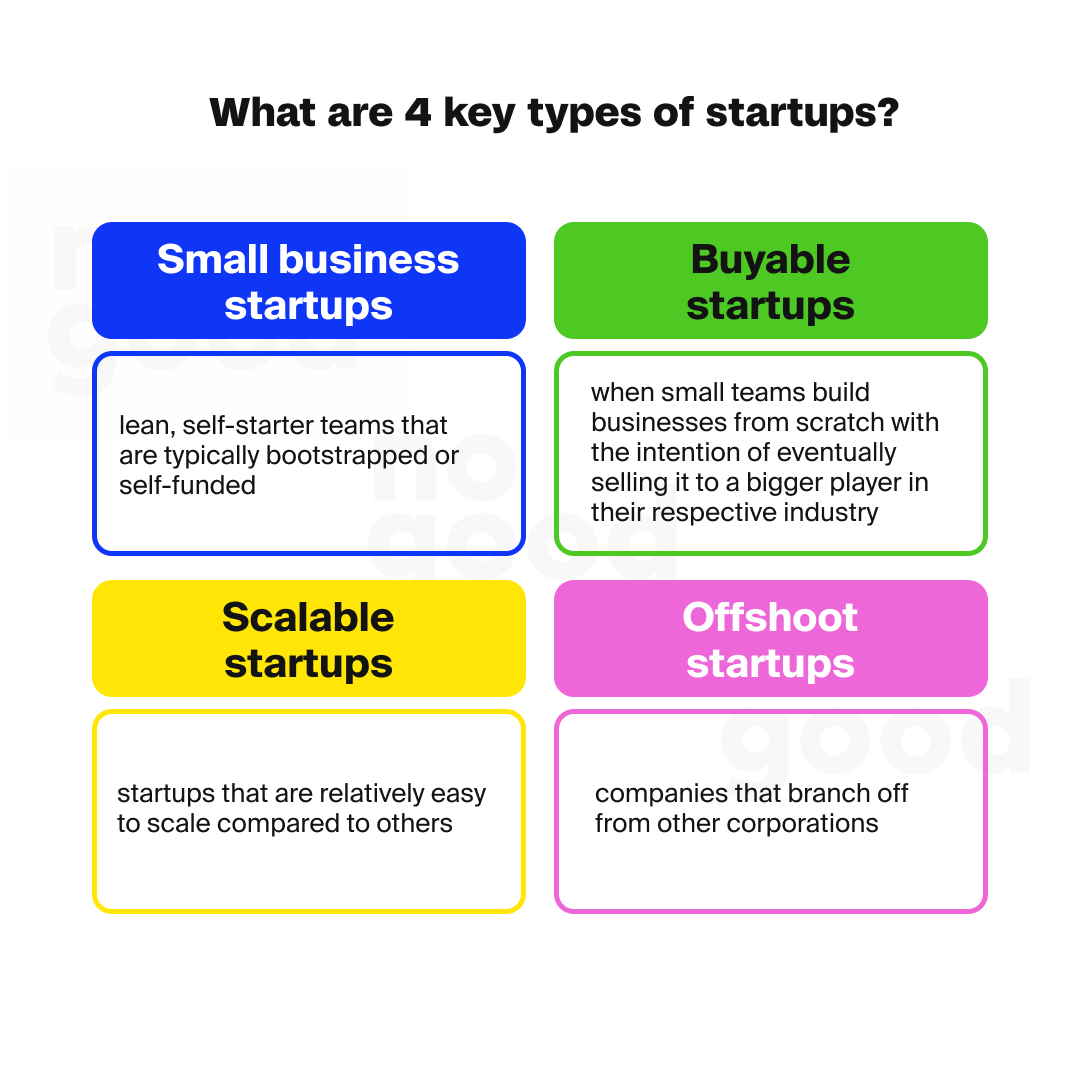
Let’s go over them one by one.
1. Small business startups
These are lean, self-starter teams that are typically bootstrapped or self-funded. Small business startups are under less pressure to scale because they are not beholden to their investors’ goals and wants, which gives them the space to grow steadily at their own pace. These types of startups benefit from creating tight-knit communities from small, initial subsets of their target consumer groups, which can then compound into organic referral and/or acquisition loops.
2. Buyable startups
Buyable startups are when small teams build businesses from scratch with the intention of eventually selling it to a bigger player in their respective industry. Common in the SaaS industry, some notable buyable startups include Adobe’s acquisition of Figma, Microsoft’s acquisition of Activision Blizzard, and Google’s acquisition of FitBit. These types of startups benefit from conducting rapid experimentation to accurately and efficiently determine product-market fit.
3. Scalable startups
The category of “scalable startups” can be misleading, as it is in the nature of all startups to eventually scale; that being said, scalable startups are the types of startups that are relatively easy to scale compared to others. Apps, particularly ones with a social element, are a prime example of a scalable startup because they have a snowball effect of growth as they acquire new users. For example, the one-photo-per-day social sharing app BeReal grew exponentially as it leveraged the network effect to gain new users and grab the attention of potential investors.
4. Offshoot startups
Contrary to buyable startups, offshoot startups are companies that branch off from other corporations. Simply put, not all startups build from the ground up — some are able to leverage the expertise and resources of their parent company while maintaining the self-starter mentality of a small startup team.
What are the best marketing strategies for startups?
With limited resources and a pressure to scale, startups benefit from marketing strategies that play into innovation and creativity while still optimizing for immediate, efficient results.
Here are our experts’ take on the 12 best startup marketing strategies to date:
1. Rapid experimentation
With rapid experimentation, quick learnings are key to scaling and positioning. With lofty goals and little time, start-ups hit the ground running with little to no stopping. Startups should adopt a rapid experimentation mindset in terms of marketing, as it’s crucial for fast growth and quick customer acquisition.
Experimentation can be implemented via any channel, to any audience, and at any point in a customer journey. Rapid experimentation offers a unique opportunity for start-ups, as it’s a fast-tracked way to unlock efficient, sustainable growth. A growth-focused startup should constantly look for new ways to reach and define their target market, as there are an unlimited number of opportunities to increase customer acquisition pace and validate product and value propositions.
2. Social Commerce
There’s no denying that social commerce is one of the most important trends of 2023. Notably, more than half of the country’s adults are making purchases on social media. When looking toward 2025, Insider Intelligence projects that social commerce will be a $79.64 billion industry in the US alone, solidifying the fact that start-ups in the eCommerce industry must integrate social commerce into their marketing strategy in one way or another.
The power of social commerce comes from its ability to combine the efficiency of e-commerce with the community-driven and convenient experience that social media platforms provide. Social commerce is particularly important for Gen Z audiences, as the preferred search engine is rapidly shifting away from Google and more towards social platforms like TikTok and Instagram. This shift gives brands the opportunity to showcase their products or services in more creative and visually engaging storytelling methods.

3. Focusing on brand and value-based marketing
Today’s consumers are no longer satisfied with just a good product that meets their needs — they want to feel good about their purchases and look for meaningful relationships with brands. Brand marketing focuses on building the core identity of the brand to appeal to potential customers’ values and ethics, shifting marketing away from a typical product-centric approach to instead a more customer-centric one.
So how should start-ups begin to approach this? Consider answering these value-based questions to determine how they pertain to your business objectives and consumer values:
- What’s memorable about your brand?
- What’s unique about your brand?
- What’s meaningful about your brand?
- Who is your brand speaking to?
- What problem does your brand solve?
- Does your brand give back? How does it give back?
After determining where your brand falls in terms of core values, consider revisiting your target audience and redefining your competitors. Identifying how competitors speak to their customers is especially important, as it provides the unique opportunity to carve out additional space in the marketplace.
Airbnb’s success is a great example of where brand marketing can prove to be more beneficial than search advertising and performance marketing. Instead of relying on search engine marketing, Airnbnb invested more into brand marketing, using PR and marketing efforts to build their overall image and attracting guests through the strength of their brand. This strategy was a logical move given that 90% of Airbnb’s platform traffic is direct (aka unaided by search advertising), and it certainly paid off as Airbnb just had their most profitable quarter yet. More and more brands today are recognizing the importance of building a strong brand and a loyal community. Consumers can no longer be bought — they have to be wooed, attracted, and convinced by an overall brand mission.
4. Leveraging a diverse set of marketing channels
Most users in the growth marketing space have been impacted by the iOS 14 update. Diversifying ad channels, or the oft-referred to “marketing mix,” is not a new concept — but diversification is arguably more important than it’s ever been in 2022. With increasingly difficult-to-close attribution data gaps and consumer privacy concerns taking center stage in 2022, marketers simply cannot risk performance by relying on one singular channel or one specific marketing tactic. Though hopping on marketing trends is tempting for all marketers, diversification is key, especially in a start-up looking to carve its place in the market.
So, where should start-ups look to diversity? Look in both new and old places. Evergreen tactics such as Google Ads, organic search, content marketing, and referral programs continue to drive success for marketers globally and have not felt the impacts as strongly as the social space has. They’re stable and have proved their longevity time and time again. Though evergreen, it doesn’t mean advertisers can’t find something new! Pairing trends with channels that have proved successful to marketers in previous years should be a strong consideration.
Tapping into TikTok as a core part of the marketing mix is also another way marketers can diversify their content across different channels. Though TikTok is not typically part of the traditional platform mix, the short-form video platform can be a powerful top-of-funnel driver for brand awareness and community engagement. The inherently rapid pace of the platform also makes it a prime channel for creative and content experimentation, and the learnings from those experiments can be leveraged to inform strategies for other channels.
5. AI Tools
With the popularization of copywriting tools like Copy.ai and Jasper.ai, as well as the rise of conversational AI like ChatGPT and Google’s Bard, leveraging AI tools is a crucial strategy to approaching startup marketing in today’s modern landscape.
Copywriters and content marketers should use AI to automate, speed up and streamline their content writing process. If and when content writers are tasked with generating a large amount of content within a short period of time, they should be using AI tools to increase the efficiency of production. By using AI for the creation part of the writing process, copywriters can spend more time on revision, refinement, and strategy — all of which are crucial in ensuring both high quality and quantity of content.
In addition to copywriting, marketers can also use AI to automate a variety of more manual tasks such as ideation, editing, summarizations, research, customer engagement, etc. Generative AI tools like ChatGPT and Google’s newly launched Bard can help startup marketers analyze large amounts of data and make better decisions to drive growth. We are living in an age where AI has become the norm; AI is shifting from a Silicon Valley toy into a real priority for a variety of different businesses and industries. Companies that do not integrate AI into their workflows, strategies and service offerings are going to fall behind those that do.
6. Gamification
Today’s consumers are constantly inundated with popups, ads, videos (cue the endless scroll trap) and more. Given the vast amount of information that is being thrown at users at all different touchpoints and platforms, gamification is a useful tool for startup marketers to hook users in and retain their attention through to the conversion phase.
The theory of gamification is rooted in the fundamental assumption that people are innately wired to want to become the best at what they do, and consequently look to be rewarded for their efforts. There are a lot of different ways to leverage gamification, whether it be through a retention-focused point system or a customization quiz for a product. At the core of any gamification strategy is to trigger consumers’ innate gameplay-mindset by activating the addictive dopamine loop that creates a natural desire to continue engaging with the brand.
7. Metaverse marketing
The lines between traditional reality and virtual reality are officially blurred, making it increasingly important for brands to understand how to connect with their consumers in the Metaverse space. Metaverse marketing is the practice of leveraging the Metaverse to build a strong brand presence through experience-forward and community-driven initiatives. Similar to point 3 regarding the importance of focusing on brand marketing, the growth of Metaverse marketing signals the need to move away from traditional marketing and focus on creating authentic, engaging brand experiences that foster strong relationships with consumers.
As a new entrant into the market, startups are at a particularly prime position to take advantage of the new developments and technologies of Metaverse marketing. The metaverse creates a whole new space for startups to build relationships with their consumers either through accessing established communities or by creating new ones. Though limited in terms of resources or scale, startups have the advantage of speed and flexibility, which becomes useful for jumping ahead of the curve and transitioning into new digital worlds in the Metaverse space. That being said, metaverse marketing can prove to be too expensive for startups that are early, so startups should reasonably evaluate if and how they decide to invest in this particular area.
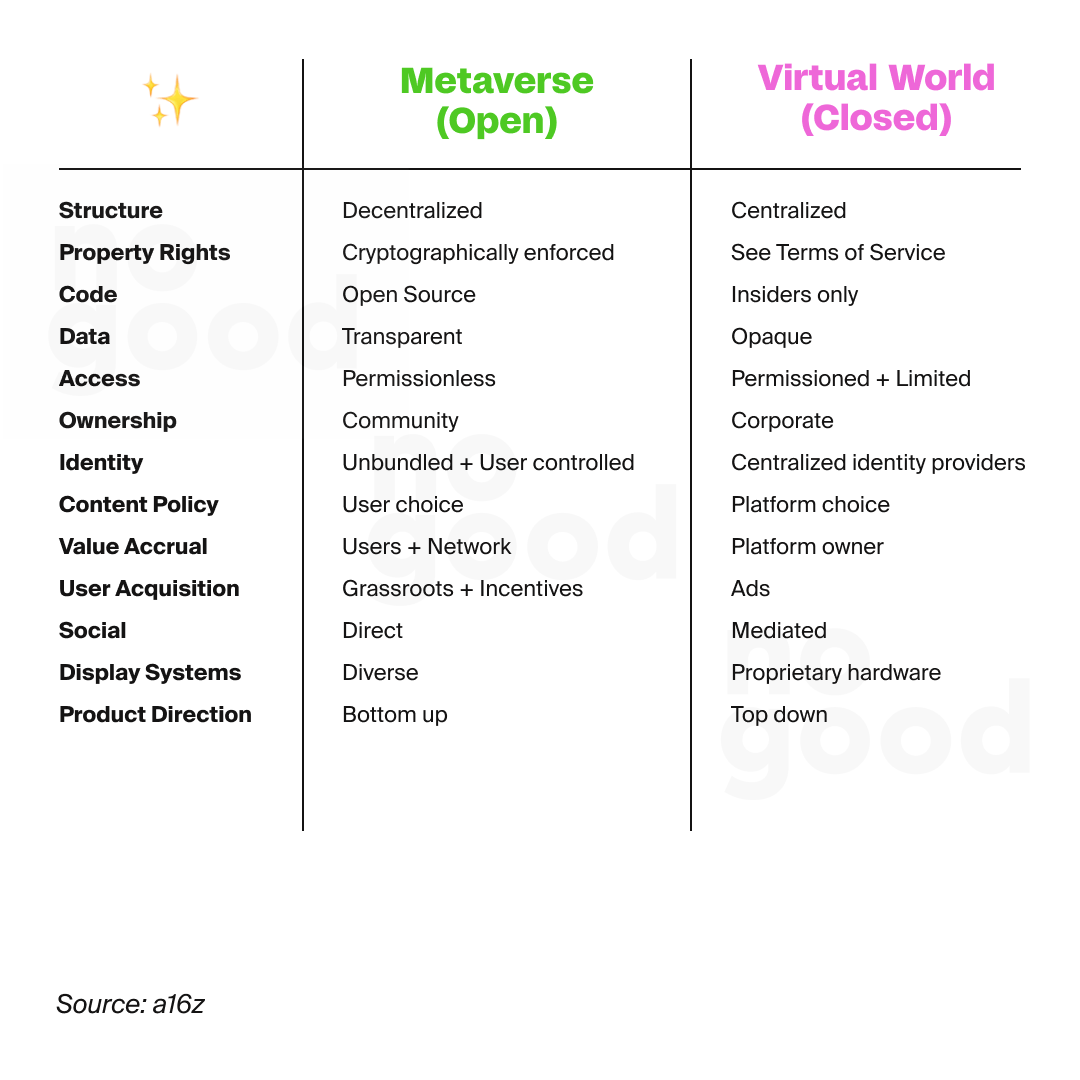
8. Community-led growth
Community-led growth is a go-to-market strategy in which companies place value beyond their product or service by providing a platform to deepen consumer and brand interactions, providing educational resources, facilitating Q&A through real-time support and feedback, and building brand loyalty, trust, and advocacy. Community-led growth tactics offer an incredible opportunity to start-ups looking to further their product based on the conversation surrounding it.
Community-led starts with a successful product and continues momentum by building on the power of its enthusiastic consumers.
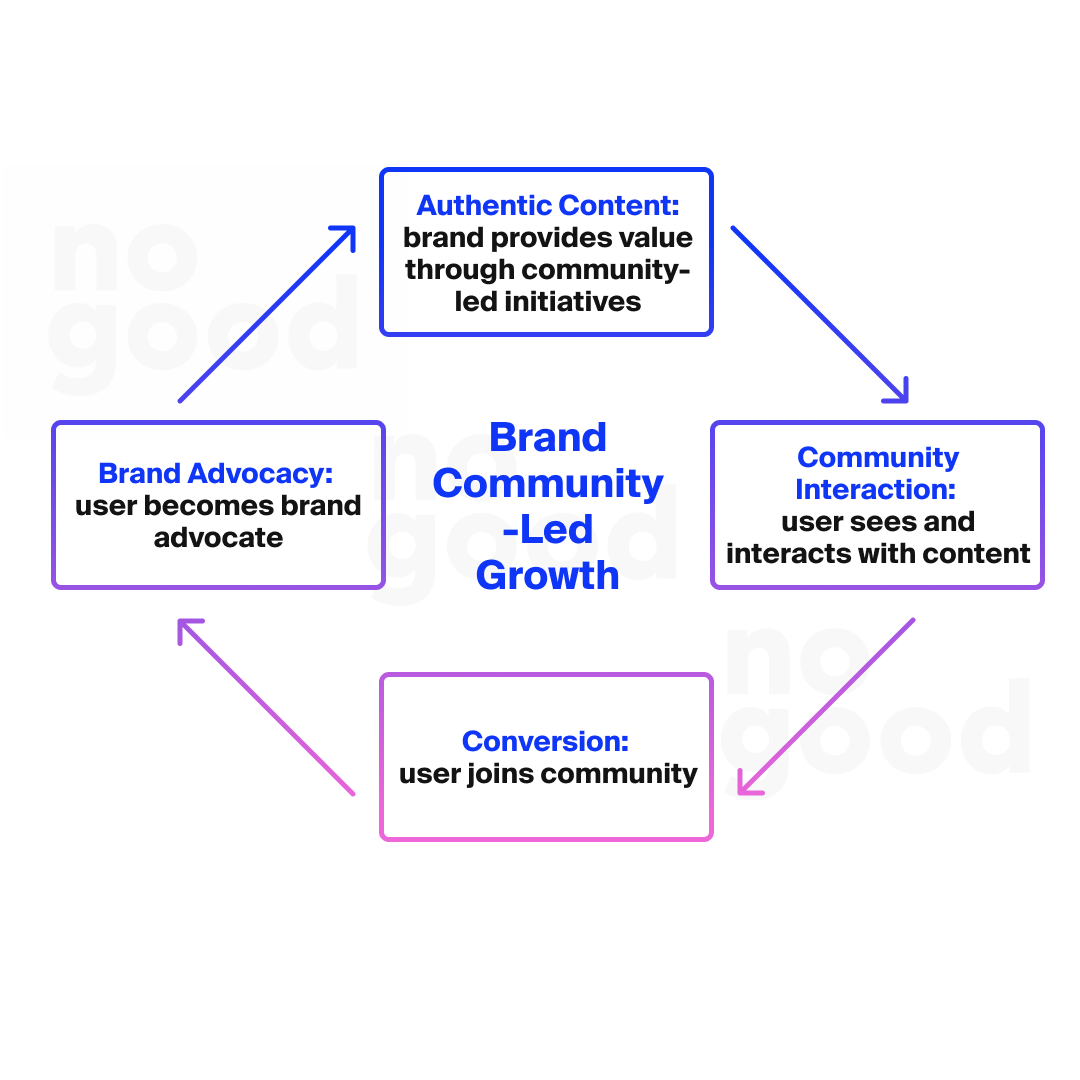
So how can start-ups take advantage of community-led growth?
- Start by identifying what motivates your audience and what values they share.
- Follow this by determining your platform – Where does your audience already live? Facebook Groups and Slack Channels are both key channels, though gaming communities communicate on platforms like Twitch and Discord, while other brands are hosting their communities on dedicated community platforms
- After setting up your community platform, start connecting and fostering a community of users who align with your brand. Encourage these community members to also subscribe to your brand-owned channels beyond social media. This includes newsletters, blogs, and podcasts.
- Gather consumer driven-data. Listen to your audience and work to understand what their interests are and what their lives look like. Once emerged, these insights can be incredibly valuable to improving your business and ideating the next steps.
- From there, you should look to expand your community’s reach via industry experts.
- Finally, your community could grow large enough to translate events offline, such as in-person events, ambassador-based sponsored events, and more.
9. Creator economy & UGC
Leveraging the rapidly growing creator economy to produce authentic UGC is a key startup marketing strategy for brands looking to gain and retain consumer trust. Brand trust is everything and leveraging UGC is one of the most efficient ways to establish it. Don’t believe us? Take a look at the stats:
- On average, 60% of people said social media content from friends and family (word of mouth) impacts their purchasing decisions, while only 23% said celebrity influencer content was impactful.
- According to a Comscore study, customer engagement is around 28% higher with user-generated content than with content that is professionally created.
- 79% of customers say user-generated content has a strong influence on their purchasing decisions.

The growing amount of sheer content that is available online is making consumers more and more skeptical — meaning brands and creators will have to shift their strategies to provide authentic, value-driven content that aligns with their target audiences’ interests and beliefs. We see this shift reflected in the way that platforms are built too, with the rise of TikTok’s interest-based algorithm and Instagram’s move to incorporate more “recommended” accounts on a user’s feed.
Given this shift towards more authentic and consumer-centric content, startups can leverage UGC to expand their top-of-funnel reach, provide social proof, and build user trust and loyalty. The raw, unfiltered aesthetic of UGC is also perfect for startups that may not have the budget to allocate to creating ads with a high production value. The nature of creator partnerships are moving towards placing an increased importance on authenticity and value as opposed to follower count, meaning startups can take advantage of smaller micro-influencers and tap into micro-communities that have a more loyal, communicative and influential fan base.
10. Personalization
Consumers want to feel like a brand sees, hears, and understands their needs — which is why personalization is so important for modern brands looking to resonate with their customers on a deeper level. Content is not a one-size-fits-all strategy; in fact, 45% of consumers said they would seek other options if a company failed to provide a personalized experience. One way to do this is through content personalization, meaning you serve site visitors with content personalized to their preferences. If feasible, start-ups should consider integrating content-oriented tools into the marketing mix to better appeal to various customer segments in various places on the funnel.
Driving growth with a future-forward mindset
Startups must be innovative, resilient, experimental, and open to challenging traditional systems that once worked. As we move into a space where physical and digital realities are being blurred and AI is becoming the norm, everything listed above will play an increasingly crucial role in the startup growth space. With that being said, we know marketing is a constantly evolving space that will never have one singular best practice. With new channel opportunities launching frequently, we’ll be keeping our eyes peeled for startups using them in their own innovative way in 2024.
